通过labelme制作coco格式数据集,包含train,val,test三部分
- 第一步,建立文件夹,标注格式采用soft-1,soft-2
- 第二步,通过creat_txt.py生成val2019.txt,train2019.txt,test2019.txt
- 第三步,通过classify.py程序将json文件与图片分类
- 第五步,通过labelme2coco.py生成train2019.json,test2019.json,val2019.json
- 可视化
- 训练
代码地址:https://github.com/Xiu7/mask-r-cnn
第一步之前,你需要安装pycocotools等工具包。
第一步,建立文件夹,标注格式采用soft-1,soft-2
文件夹列表如下:
1
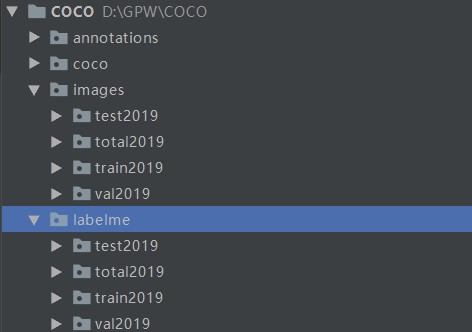
1. labelme/total2019下存放labelme生成的json文件,images/total2019下存放图片,其他文件夹先不用管
2. 下图时整体目录,后边建py文件参考
3. 注意一张图片里的多个同类目标采用soft-1,soft-2,soft-3,这类方式命名
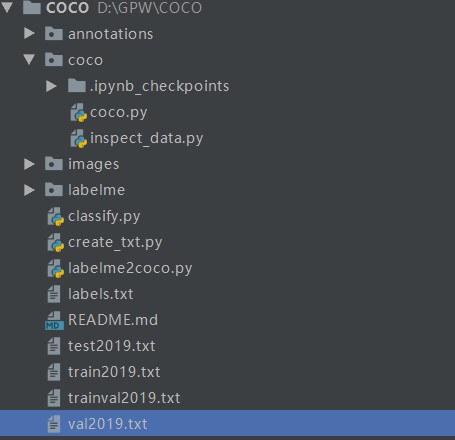
第二步,通过creat_txt.py生成val2019.txt,train2019.txt,test2019.txt
程序如下,通过trainval_percent ,train_percent 参数设置train,test,val数据集的比例,程序直接运行
1
2
3
4
5
6
7
8
9
10
11
12
13
14
15
16
17
18
19
20
21
22
23
24
25
26
27
28
29
30
31
32
33
34
35
36
37
38
39# !/usr/bin/python # -*- coding: utf-8 -*- import os import random trainval_percent = 0.8 # 验证集+训练集占总比例多少 train_percent = 0.7 # 训练数据集占验证集+训练集比例多少 jsonfilepath = 'labelme/total2019' txtsavepath = './' total_xml = os.listdir(jsonfilepath) num = len(total_xml) list = range(num) tv = int(num * trainval_percent) tr = int(tv * train_percent) trainval = random.sample(list, tv) train = random.sample(trainval, tr) ftrainval = open('./trainval2019.txt', 'w') ftest = open('./test2019.txt', 'w') ftrain = open('./train2019.txt', 'w') fval = open('./val2019.txt', 'w') for i in list: name = total_xml[i][:-5] + 'n' if i in trainval: ftrainval.write(name) if i in train: ftrain.write(name) else: fval.write(name) else: ftest.write(name) ftrainval.close() ftrain.close() fval.close() ftest.close()
生成后txt文件后文件结构如下:
1
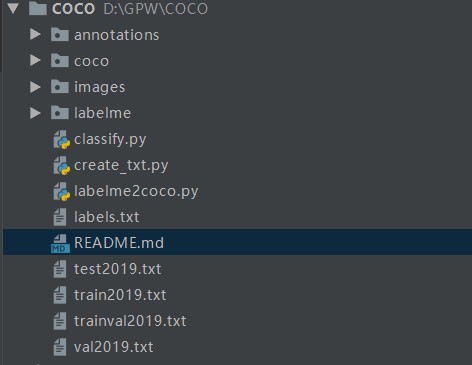
第三步,通过classify.py程序将json文件与图片分类
代码如下,程序直接运行
1
2
3
4
5
6
7
8
9
10
11
12
13
14
15import shutil import cv2 as cv sets=['train2019', 'val2019', 'test2019'] for image_set in sets: image_ids = open('./%s.txt'%(image_set)).read().strip().split() for image_id in image_ids: img = cv.imread('images/total2019/%s.jpg' % (image_id)) json='labelme/total2019/%s.json'% (image_id) cv.imwrite('images/%s/%s.jpg' % (image_set,image_id), img) cv.imwrite('labelme/%s/%s.jpg' % (image_set,image_id), img) shutil.copy(json,'labelme/%s/%s.json' % (image_set,image_id)) print("完成")
第五步,通过labelme2coco.py生成train2019.json,test2019.json,val2019.json
在根目录下建立labels.txt文件,内容首行为__ignore__,后续为你的分类标签。样例如下
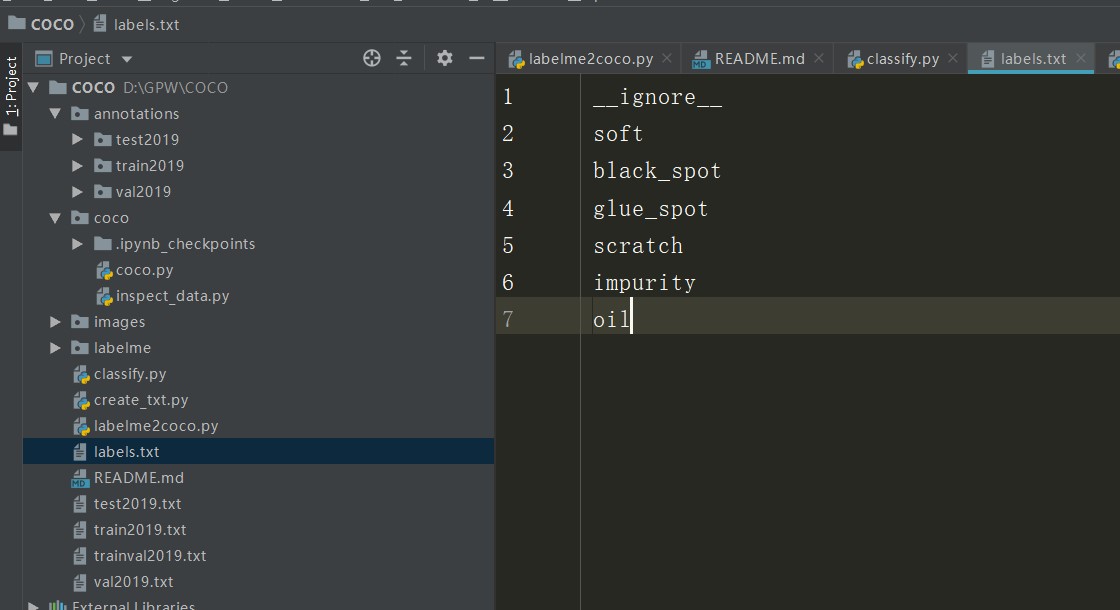
建立labelme2coco.py文件,代码如下
1
2
3
4
5
6
7
8
9
10
11
12
13
14
15
16
17
18
19
20
21
22
23
24
25
26
27
28
29
30
31
32
33
34
35
36
37
38
39
40
41
42
43
44
45
46
47
48
49
50
51
52
53
54
55
56
57
58
59
60
61
62
63
64
65
66
67
68
69
70
71
72
73
74
75
76
77
78
79
80
81
82
83
84
85
86
87
88
89
90
91
92
93
94
95
96
97
98
99
100
101
102
103
104
105
106
107
108
109
110
111
112
113
114
115
116
117
118
119
120
121
122
123
124
125
126
127
128
129
130
131
132
133
134
135
136
137
138
139
140
141
142
143
144
145
146
147
148
149
150
151
152
153
154
155#!/usr/bin/env python import argparse import collections import datetime import glob import json import os import os.path as osp import sys import numpy as np import PIL.Image import labelme try: import pycocotools.mask except ImportError: print('Please install pycocotools:nn pip install pycocotoolsn') sys.exit(1) def main(): parser = argparse.ArgumentParser( formatter_class=argparse.ArgumentDefaultsHelpFormatter ) parser.add_argument('--input_dir', help='input annotated directory') parser.add_argument('--output_dir', help='output dataset directory') parser.add_argument('--filename', help='output filename') parser.add_argument('--labels', help='labels file', required=True) args = parser.parse_args() if osp.exists(args.output_dir): print('Output directory already exists:', args.output_dir) sys.exit(1) os.makedirs(args.output_dir) os.makedirs(osp.join(args.output_dir, 'JPEGImages')) print('Creating dataset:', args.output_dir) now = datetime.datetime.now() data = dict( info=dict( description=None, url=None, version=None, year=now.year, contributor=None, date_created=now.strftime('%Y-%m-%d %H:%M:%S.%f'), ), licenses=[dict( url=None, id=0, name=None, )], images=[ # license, url, file_name, height, width, date_captured, id ], type='instances', annotations=[ # segmentation, area, iscrowd, image_id, bbox, category_id, id ], categories=[ # supercategory, id, name ], ) class_name_to_id = {} for i, line in enumerate(open(args.labels).readlines()): class_id = i - 1 # starts with -1 class_name = line.strip() if class_id == -1: assert class_name == '__ignore__' continue class_name_to_id[class_name] = class_id data['categories'].append(dict( supercategory=None, id=class_id, name=class_name, )) out_ann_file = osp.join(args.output_dir, args.filename+'.json') label_files = glob.glob(osp.join(args.input_dir, '*.json')) for image_id, label_file in enumerate(label_files): print('Generating dataset from:', label_file) with open(label_file) as f: label_data = json.load(f) base = osp.splitext(osp.basename(label_file))[0] out_img_file = osp.join( args.output_dir, 'JPEGImages', base + '.jpg' ) path=label_data['imagePath'].split("\") img_file = osp.join( osp.dirname(label_file), path[2] ) img = np.asarray(PIL.Image.open(img_file)) PIL.Image.fromarray(img).save(out_img_file) data['images'].append(dict( license=0, url=None, file_name=osp.relpath(out_img_file, osp.dirname(out_ann_file)), height=img.shape[0], width=img.shape[1], date_captured=None, id=image_id, )) masks = {} # for area segmentations = collections.defaultdict(list) # for segmentation for shape in label_data['shapes']: points = shape['points'] label = shape['label'] shape_type = shape.get('shape_type', None) mask = labelme.utils.shape_to_mask( img.shape[:2], points, shape_type ) if label in masks: masks[label] = masks[label] | mask else: masks[label] = mask points = np.asarray(points).flatten().tolist() segmentations[label].append(points) for label, mask in masks.items(): cls_name = label.split('-')[0] if cls_name not in class_name_to_id: continue cls_id = class_name_to_id[cls_name] mask = np.asfortranarray(mask.astype(np.uint8)) mask = pycocotools.mask.encode(mask) area = float(pycocotools.mask.area(mask)) bbox = pycocotools.mask.toBbox(mask).flatten().tolist() data['annotations'].append(dict( id=len(data['annotations']), image_id=image_id, category_id=cls_id, segmentation=segmentations[label], area=area, bbox=bbox, iscrowd=0, )) with open(out_ann_file, 'w') as f: json.dump(data, f) if __name__ == '__main__': main()
运行三次labelme2coco.py文件,在annotations下生成coco格式的文件,指令如下
1
2python ./labelme2coco.py --input_dir ./labelme/train2019 --output_dir ./annotations/train2019 --filename instances_train2019 --labels labels.txt
1
2python ./labelme2coco.py --input_dir ./labelme/val2019 --output_dir ./annotations/val2019 --filename instances_val2019 --labels labels.txt
1
2python ./labelme2coco.py --input_dir ./labelme/test2019 --output_dir ./annotations/test2019 --filename instances_test2019 --labels labels.txt
可视化
在coco文件夹下建立coco.py与inspect_data.py
coco.py代码如下
1
2
3
4
5
6
7
8
9
10
11
12
13
14
15
16
17
18
19
20
21
22
23
24
25
26
27
28
29
30
31
32
33
34
35
36
37
38
39
40
41
42
43
44
45
46
47
48
49
50
51
52
53
54
55
56
57
58
59
60
61
62
63
64
65
66
67
68
69
70
71
72
73
74
75
76
77
78
79
80
81
82
83
84
85
86
87
88
89
90
91
92
93
94
95
96
97
98
99
100
101
102
103
104
105
106
107
108
109
110
111
112
113
114
115
116
117
118
119
120
121
122
123
124
125
126
127
128
129
130
131
132
133
134
135
136
137
138
139
140
141
142
143
144
145
146
147
148
149
150
151
152
153
154
155
156
157
158
159
160
161
162
163
164
165
166
167
168
169
170
171
172
173
174
175
176
177
178
179
180
181
182
183
184
185
186
187
188
189
190
191
192
193
194
195
196
197
198
199
200
201
202
203
204
205
206
207
208
209
210
211
212
213
214
215
216
217
218
219
220
221
222
223
224
225
226
227
228
229
230
231
232
233
234
235
236
237
238
239
240
241
242
243
244
245
246
247
248
249
250
251
252
253
254
255
256
257
258
259
260
261
262
263
264
265
266
267
268
269
270
271
272
273
274
275
276
277
278
279
280
281
282
283
284
285
286
287
288
289
290
291
292
293
294
295
296
297
298
299
300
301
302
303
304
305
306
307
308
309
310
311
312
313
314
315
316
317
318
319
320
321
322
323
324
325
326
327
328
329
330
331
332
333
334
335
336
337
338
339
340
341
342
343
344
345
346
347
348
349
350
351
352
353
354
355
356
357
358
359
360
361
362
363
364
365
366
367
368
369
370
371
372
373
374
375
376
377
378
379
380
381
382
383
384
385
386
387
388
389
390
391
392
393
394
395
396
397
398
399
400
401
402
403
404
405
406
407
408
409
410
411
412
413
414
415
416
417
418
419
420
421
422
423
424
425
426
427
428
429
430
431
432
433
434
435
436
437
438
439
440
441
442
443
444
445
446
447
448
449
450
451
452
453
454
455
456
457
458
459
460
461
462
463
464
465
466
467
468
469
470
471
472
473
474
475
476
477
478
479
480
481
482
483
484
485
486
487
488
489
490
491
492
493
494
495
496
497
498
499
500
501
502
503
504
505
506
507
508
509
510
511
512
513
514
515
516
517
518
519
520
521
522
523
524
525
526
527
528
529
530
531
532
533
534
535
536""" Mask R-CNN Configurations and data loading code for MS COCO. Copyright (c) 2017 Matterport, Inc. Licensed under the MIT License (see LICENSE for details) Written by Waleed Abdulla ------------------------------------------------------------ Usage: import the module (see Jupyter notebooks for examples), or run from the command line as such: # Train a new model starting from pre-trained COCO weights python3 coco.py train --dataset=/path/to/coco/ --model=coco # Train a new model starting from ImageNet weights. Also auto download COCO dataset python3 coco.py train --dataset=/path/to/coco/ --model=imagenet --download=True # Continue training a model that you had trained earlier python3 coco.py train --dataset=/path/to/coco/ --model=/path/to/weights.h5 # Continue training the last model you trained python3 coco.py train --dataset=/path/to/coco/ --model=last # Run COCO evaluatoin on the last model you trained python3 coco.py evaluate --dataset=/path/to/coco/ --model=last """ import os import sys import time import numpy as np import imgaug # https://github.com/aleju/imgaug (pip3 install imgaug) # Download and install the Python COCO tools from https://github.com/waleedka/coco # That's a fork from the original https://github.com/pdollar/coco with a bug # fix for Python 3. # I submitted a pull request https://github.com/cocodataset/cocoapi/pull/50 # If the PR is merged then use the original repo. # Note: Edit PythonAPI/Makefile and replace "python" with "python3". from pycocotools.coco import COCO from pycocotools.cocoeval import COCOeval from pycocotools import mask as maskUtils import zipfile import urllib.request import shutil # Root directory of the project ROOT_DIR = os.path.abspath("model") # Import Mask RCNN sys.path.append(ROOT_DIR) # To find local version of the library from mrcnn.config import Config from mrcnn import model as modellib, utils # Path to trained weights file COCO_MODEL_PATH = os.path.join(ROOT_DIR, "mask_rcnn_coco.h5") # Directory to save logs and model checkpoints, if not provided # through the command line argument --logs DEFAULT_LOGS_DIR = os.path.join(ROOT_DIR, "logs") DEFAULT_DATASET_YEAR = "2019" ############################################################ # Configurations ############################################################ class CocoConfig(Config): """Configuration for training on MS COCO. Derives from the base Config class and overrides values specific to the COCO dataset. """ # Give the configuration a recognizable name NAME = "coco" # We use a GPU with 12GB memory, which can fit two images. # Adjust down if you use a smaller GPU. IMAGES_PER_GPU = 1 # Uncomment to train on 8 GPUs (default is 1) # GPU_COUNT = 8 # Number of classes (including background) NUM_CLASSES = 1 + 6 # COCO has 80 classes ############################################################ # Dataset ############################################################ class CocoDataset(utils.Dataset): def load_coco(self, dataset_dir, subset, year=DEFAULT_DATASET_YEAR, class_ids=None, class_map=None, return_coco=False, auto_download=False): """Load a subset of the COCO dataset. dataset_dir: The root directory of the COCO dataset. subset: What to load (train, val, minival, valminusminival) year: What dataset year to load (2014, 2017) as a string, not an integer class_ids: If provided, only loads images that have the given classes. class_map: TODO: Not implemented yet. Supports maping classes from different datasets to the same class ID. return_coco: If True, returns the COCO object. auto_download: Automatically download and unzip MS-COCO images and train """ if auto_download is True: self.auto_download(dataset_dir, subset, year) coco = COCO("{}/train2019/instances_{}{}.json".format(dataset_dir, subset, year)) if subset == "minival" or subset == "valminusminival": subset = "val" image_dir = "{}/{}{}".format(dataset_dir, subset, year) # Load all classes or a subset? if not class_ids: # All classes class_ids = sorted(coco.getCatIds()) # All images or a subset? if class_ids: image_ids = [] for id in class_ids: image_ids.extend(list(coco.getImgIds(catIds=[id]))) # Remove duplicates image_ids = list(set(image_ids)) else: # All images image_ids = list(coco.imgs.keys()) # Add classes for i in class_ids: self.add_class("coco", i, coco.loadCats(i)[0]["name"]) # Add images for i in image_ids: self.add_image( "coco", image_id=i, path=os.path.join(image_dir, coco.imgs[i]['file_name']), width=coco.imgs[i]["width"], height=coco.imgs[i]["height"], annotations=coco.loadAnns(coco.getAnnIds( imgIds=[i], catIds=class_ids, iscrowd=None))) if return_coco: return coco def auto_download(self, dataDir, dataType, dataYear): """Download the COCO dataset/train if requested. dataDir: The root directory of the COCO dataset. dataType: What to load (train, val, minival, valminusminival) dataYear: What dataset year to load (2014, 2017) as a string, not an integer Note: For 2014, use "train", "val", "minival", or "valminusminival" For 2017, only "train" and "val" train are available """ # Setup paths and file names if dataType == "minival" or dataType == "valminusminival": imgDir = "{}/{}{}".format(dataDir, "val", dataYear) imgZipFile = "{}/{}{}.zip".format(dataDir, "val", dataYear) imgURL = "http://images.cocodataset.org/zips/{}{}.zip".format("val", dataYear) else: imgDir = "{}/{}{}".format(dataDir, dataType, dataYear) imgZipFile = "{}/{}{}.zip".format(dataDir, dataType, dataYear) imgURL = "http://images.cocodataset.org/zips/{}{}.zip".format(dataType, dataYear) # print("Image paths:"); print(imgDir); print(imgZipFile); print(imgURL) # Create main folder if it doesn't exist yet if not os.path.exists(dataDir): os.makedirs(dataDir) # Download images if not available locally if not os.path.exists(imgDir): os.makedirs(imgDir) print("Downloading images to " + imgZipFile + " ...") with urllib.request.urlopen(imgURL) as resp, open(imgZipFile, 'wb') as out: shutil.copyfileobj(resp, out) print("... done downloading.") print("Unzipping " + imgZipFile) with zipfile.ZipFile(imgZipFile, "r") as zip_ref: zip_ref.extractall(dataDir) print("... done unzipping") print("Will use images in " + imgDir) # Setup train data paths annDir = "{}/train".format(dataDir) if dataType == "minival": annZipFile = "{}/instances_minival2014.json.zip".format(dataDir) annFile = "{}/instances_minival2014.json".format(annDir) annURL = "https://dl.dropboxusercontent.com/s/o43o90bna78omob/instances_minival2014.json.zip?dl=0" unZipDir = annDir elif dataType == "valminusminival": annZipFile = "{}/instances_valminusminival2014.json.zip".format(dataDir) annFile = "{}/instances_valminusminival2014.json".format(annDir) annURL = "https://dl.dropboxusercontent.com/s/s3tw5zcg7395368/instances_valminusminival2014.json.zip?dl=0" unZipDir = annDir else: annZipFile = "{}/annotations_trainval{}.zip".format(dataDir, dataYear) annFile = "{}/instances_{}{}.json".format(annDir, dataType, dataYear) annURL = "http://images.cocodataset.org/annotations/annotations_trainval{}.zip".format(dataYear) unZipDir = dataDir # print("Annotations paths:"); print(annDir); print(annFile); print(annZipFile); print(annURL) # Download train if not available locally if not os.path.exists(annDir): os.makedirs(annDir) if not os.path.exists(annFile): if not os.path.exists(annZipFile): print("Downloading zipped train to " + annZipFile + " ...") with urllib.request.urlopen(annURL) as resp, open(annZipFile, 'wb') as out: shutil.copyfileobj(resp, out) print("... done downloading.") print("Unzipping " + annZipFile) with zipfile.ZipFile(annZipFile, "r") as zip_ref: zip_ref.extractall(unZipDir) print("... done unzipping") print("Will use train in " + annFile) def load_mask(self, image_id): """Load instance masks for the given image. Different datasets use different ways to store masks. This function converts the different mask format to one format in the form of a bitmap [height, width, instances]. Returns: masks: A bool array of shape [height, width, instance count] with one mask per instance. class_ids: a 1D array of class IDs of the instance masks. """ # If not a COCO image, delegate to parent class. image_info = self.image_info[image_id] if image_info["source"] != "coco": return super(CocoDataset, self).load_mask(image_id) instance_masks = [] class_ids = [] annotations = self.image_info[image_id]["annotations"] # Build mask of shape [height, width, instance_count] and list # of class IDs that correspond to each channel of the mask. for annotation in annotations: class_id = self.map_source_class_id( "coco.{}".format(annotation['category_id'])) if class_id: m = self.annToMask(annotation, image_info["height"], image_info["width"]) # Some objects are so small that they're less than 1 pixel area # and end up rounded out. Skip those objects. if m.max() < 1: continue # Is it a crowd? If so, use a negative class ID. if annotation['iscrowd']: # Use negative class ID for crowds class_id *= -1 # For crowd masks, annToMask() sometimes returns a mask # smaller than the given dimensions. If so, resize it. if m.shape[0] != image_info["height"] or m.shape[1] != image_info["width"]: m = np.ones([image_info["height"], image_info["width"]], dtype=bool) instance_masks.append(m) class_ids.append(class_id) # Pack instance masks into an array if class_ids: mask = np.stack(instance_masks, axis=2).astype(np.bool) class_ids = np.array(class_ids, dtype=np.int32) return mask, class_ids else: # Call super class to return an empty mask return super(CocoDataset, self).load_mask(image_id) def image_reference(self, image_id): """Return a link to the image in the COCO Website.""" info = self.image_info[image_id] if info["source"] == "coco": return "http://cocodataset.org/#explore?id={}".format(info["id"]) else: super(CocoDataset, self).image_reference(image_id) # The following two functions are from pycocotools with a few changes. def annToRLE(self, ann, height, width): """ Convert annotation which can be polygons, uncompressed RLE to RLE. :return: binary mask (numpy 2D array) """ segm = ann['segmentation'] if isinstance(segm, list): # polygon -- a single object might consist of multiple parts # we merge all parts into one mask rle code rles = maskUtils.frPyObjects(segm, height, width) rle = maskUtils.merge(rles) elif isinstance(segm['counts'], list): # uncompressed RLE rle = maskUtils.frPyObjects(segm, height, width) else: # rle rle = ann['segmentation'] return rle def annToMask(self, ann, height, width): """ Convert annotation which can be polygons, uncompressed RLE, or RLE to binary mask. :return: binary mask (numpy 2D array) """ rle = self.annToRLE(ann, height, width) m = maskUtils.decode(rle) return m ############################################################ # COCO Evaluation ############################################################ def build_coco_results(dataset, image_ids, rois, class_ids, scores, masks): """Arrange resutls to match COCO specs in http://cocodataset.org/#format """ # If no results, return an empty list if rois is None: return [] results = [] for image_id in image_ids: # Loop through detections for i in range(rois.shape[0]): class_id = class_ids[i] score = scores[i] bbox = np.around(rois[i], 1) mask = masks[:, :, i] result = { "image_id": image_id, "category_id": dataset.get_source_class_id(class_id, "coco"), "bbox": [bbox[1], bbox[0], bbox[3] - bbox[1], bbox[2] - bbox[0]], "score": score, "segmentation": maskUtils.encode(np.asfortranarray(mask)) } results.append(result) return results def evaluate_coco(model, dataset, coco, eval_type="bbox", limit=0, image_ids=None): """Runs official COCO evaluation. dataset: A Dataset object with valiadtion data eval_type: "bbox" or "segm" for bounding box or segmentation evaluation limit: if not 0, it's the number of images to use for evaluation """ # Pick COCO images from the dataset image_ids = image_ids or dataset.image_ids # Limit to a subset if limit: image_ids = image_ids[:limit] # Get corresponding COCO image IDs. coco_image_ids = [dataset.image_info[id]["id"] for id in image_ids] t_prediction = 0 t_start = time.time() results = [] for i, image_id in enumerate(image_ids): # Load image image = dataset.load_image(image_id) # Run detection t = time.time() r = model.detect([image], verbose=0)[0] t_prediction += (time.time() - t) # Convert results to COCO format # Cast masks to uint8 because COCO tools errors out on bool image_results = build_coco_results(dataset, coco_image_ids[i:i + 1], r["rois"], r["class_ids"], r["scores"], r["masks"].astype(np.uint8)) results.extend(image_results) # Load results. This modifies results with additional attributes. coco_results = coco.loadRes(results) # Evaluate cocoEval = COCOeval(coco, coco_results, eval_type) cocoEval.params.imgIds = coco_image_ids cocoEval.evaluate() cocoEval.accumulate() cocoEval.summarize() print("Prediction time: {}. Average {}/image".format( t_prediction, t_prediction / len(image_ids))) print("Total time: ", time.time() - t_start) ############################################################ # Training ############################################################ if __name__ == '__main__': import argparse # Parse command line arguments parser = argparse.ArgumentParser( description='Train Mask R-CNN on MS COCO.') parser.add_argument("command", metavar="<command>", help="'train' or 'evaluate' on MS COCO") parser.add_argument('--dataset', required=True, metavar="/path/to/coco/", help='Directory of the MS-COCO dataset') parser.add_argument('--year', required=False, default=DEFAULT_DATASET_YEAR, metavar="<year>", help='Year of the MS-COCO dataset (2014 or 2017) (default=2014)') parser.add_argument('--model', required=True, metavar="/path/to/weights.h5", help="Path to weights .h5 file or 'coco'") parser.add_argument('--logs', required=False, default=DEFAULT_LOGS_DIR, metavar="/path/to/logs/", help='Logs and checkpoints directory (default=logs/)') parser.add_argument('--limit', required=False, default=500, metavar="<image count>", help='Images to use for evaluation (default=500)') parser.add_argument('--download', required=False, default=False, metavar="<True|False>", help='Automatically download and unzip MS-COCO files (default=False)', type=bool) args = parser.parse_args() print("Command: ", args.command) print("Model: ", args.model) print("Dataset: ", args.dataset) print("Year: ", args.year) print("Logs: ", args.logs) print("Auto Download: ", args.download) # Configurations if args.command == "train": config = CocoConfig() else: class InferenceConfig(CocoConfig): # Set batch size to 1 since we'll be running inference on # one image at a time. Batch size = GPU_COUNT * IMAGES_PER_GPU GPU_COUNT = 1 IMAGES_PER_GPU = 1 DETECTION_MIN_CONFIDENCE = 0 config = InferenceConfig() config.display() # Create model if args.command == "train": model = modellib.MaskRCNN(mode="training", config=config, model_dir=args.logs) else: model = modellib.MaskRCNN(mode="inference", config=config, model_dir=args.logs) # Select weights file to load if args.model.lower() == "coco": model_path = COCO_MODEL_PATH elif args.model.lower() == "last": # Find last trained weights model_path = model.find_last() elif args.model.lower() == "imagenet": # Start from ImageNet trained weights model_path = model.get_imagenet_weights() else: model_path = args.model # Load weights print("Loading weights ", model_path) model.load_weights(model_path, by_name=True) # Train or evaluate if args.command == "train": # Training dataset. Use the training set and 35K from the # validation set, as as in the Mask RCNN paper. dataset_train = CocoDataset() dataset_train.load_coco(args.dataset, "train", year=args.year, auto_download=args.download) if args.year in '2014': dataset_train.load_coco(args.dataset, "valminusminival", year=args.year, auto_download=args.download) dataset_train.prepare() # Validation dataset dataset_val = CocoDataset() val_type = "val" if args.year in '2017' else "minival" dataset_val.load_coco(args.dataset, val_type, year=args.year, auto_download=args.download) dataset_val.prepare() # Image Augmentation # Right/Left flip 50% of the time augmentation = imgaug.augmenters.Fliplr(0.5) # *** This training schedule is an example. Update to your needs *** # Training - Stage 1 print("Training network heads") model.train(dataset_train, dataset_val, learning_rate=config.LEARNING_RATE, epochs=40, layers='heads', augmentation=augmentation) # Training - Stage 2 # Finetune layers from ResNet stage 4 and up print("Fine tune Resnet stage 4 and up") model.train(dataset_train, dataset_val, learning_rate=config.LEARNING_RATE, epochs=120, layers='4+', augmentation=augmentation) # Training - Stage 3 # Fine tune all layers print("Fine tune all layers") model.train(dataset_train, dataset_val, learning_rate=config.LEARNING_RATE / 10, epochs=160, layers='all', augmentation=augmentation) elif args.command == "evaluate": # Validation dataset dataset_val = CocoDataset() val_type = "val" if args.year in '2017' else "minival" coco = dataset_val.load_coco(args.dataset, val_type, year=args.year, return_coco=True, auto_download=args.download) dataset_val.prepare() print("Running COCO evaluation on {} images.".format(args.limit)) evaluate_coco(model, dataset_val, coco, "bbox", limit=int(args.limit)) else: print("'{}' is not recognized. " "Use 'train' or 'evaluate'".format(args.command))
inspect_data.py代码如下
1
2
3
4
5
6
7
8
9
10
11
12
13
14
15
16
17
18
19
20
21
22
23
24
25
26
27
28
29
30
31
32
33
34
35
36
37
38import os import sys import numpy as np ROOT_DIR = os.path.abspath("../") # Import Mask RCNN sys.path.append(ROOT_DIR) # To find local version of the library from mrcnn import utils from mrcnn import visualize # MS COCO Dataset import coco config = coco.CocoConfig() COCO_DIR = "../annotations" # TODO: enter value here # Load dataset if config.NAME == 'shapes': dataset = shapes.ShapesDataset() dataset.load_shapes(500, config.IMAGE_SHAPE[0], config.IMAGE_SHAPE[1]) elif config.NAME == "coco": dataset = coco.CocoDataset() dataset.load_coco(COCO_DIR, "train") # Must call before using the dataset dataset.prepare() print("Image Count: {}".format(len(dataset.image_ids))) print("Class Count: {}".format(dataset.num_classes)) for i, info in enumerate(dataset.class_info): print("{:3}. {:50}".format(i, info['name'])) # Load and display random samples image_ids = np.random.choice(dataset.image_ids, 3) print(image_ids) for image_id in image_ids: image = dataset.load_image(image_id) mask, class_ids = dataset.load_mask(image_id) visualize.display_top_masks(image, mask, class_ids, dataset.class_names)
运行inspect_data.py,即可可视化数据集
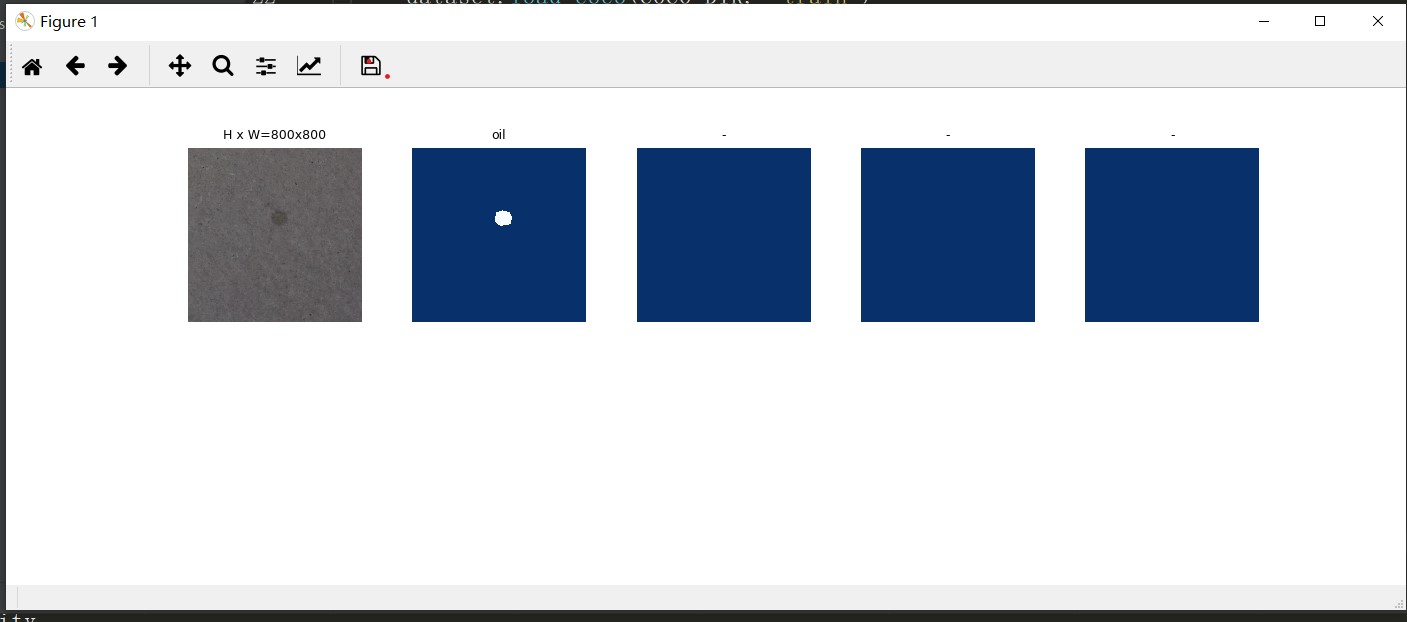
训练
第一步,在model中存放mask_rcnn_coco.h5模型
第二步,修改mdf.py参数,87行修改成自己的分类数(mdf.py 就是samples/coco中的coco.py,我重命名了一下)
最后一步,输入python mdf.py train --dataset=./coco_mdf --model=coco开始训练
最后
以上就是含糊蜡烛最近收集整理的关于通过labelme制作coco格式数据集,并使用mask r-cnn训练的全部内容,更多相关通过labelme制作coco格式数据集,并使用mask内容请搜索靠谱客的其他文章。








发表评论 取消回复